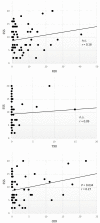Sleep-Related Breathing Disorders in Multiple Sclerosis: Prevalence, Features and Associated Factors
- PMID: 35478718
- PMCID: PMC9035459
- DOI: 10.2147/NSS.S359858
Sleep-Related Breathing Disorders in Multiple Sclerosis: Prevalence, Features and Associated Factors
Abstract
Background: Multiple sclerosis (MS) represents a risk factor for sleep disorders, but there are conflicting results about the prevalence and severity of sleep-related breathing disorders (SRBD) in MS. Most available data come from self-administered questionnaires.
Objective: To conduct a polysomnographic study in MS focused on SRBD, compared to a group of healthy controls (HC), also considering the neuroimaging findings. To evaluate the impact of SRBD on vigilance, fatigue and depression in MS.
Methods: In this cross-sectional, observational, instrumental study, 67 MS patients (men/women: 20/47; mean age: 50.6±8.2 years) underwent PSG and maintenance of wakefulness test. Findings were compared to 67 age-, sex-, BMI-matched HC, by using parametric (Student's t-test) and nonparametric statistics (chi-squared test). A subgroup analysis was then performed, evaluating the influence of brainstem (mesencephalic, pontine and medullary) lesions at neuroimaging on instrumental and clinical data: MS patients with at least one brainstem lesion vs MS patients without vs HC.
Results: The frequency of SRBD was comparable in MS patients and HC. No MS patient had a central apnea index ≥2/h. The respiratory disturbance index (RDI) did not correlate to clinical parameters such as fatigue and depression. Patients with MS were drowsier than HC (47% vs 26%, p = 0.019) and showed a worse sleep pattern, in terms of duration, efficiency and architecture.
Conclusion: Our study does not provide evidence of an association between MS-specific symptoms such as fatigue, sleepiness, depression and central or obstructive apneas, even in the presence of brainstem lesions.
Keywords: multiple sclerosis; polysomnography; sleep quality; sleep-related breathing disorders.
© 2022 Sparasci et al.
Conflict of interest statement
R.F. was partially supported by a fund of the Italian Ministry of Health (RC2764026). CZ reports grants from Swiss MS Society, during the conduct of the study; grants from Abbvie, Almirall, Biogen Idec, Bristol Meyer Squibb, Genzyme, Lundbeck, Merck, Novartis, Teva Pharma, and Roche, outside the submitted work. The authors report no other conflicts of interest in this work.
Figures
References
LinkOut - more resources
Full Text Sources



